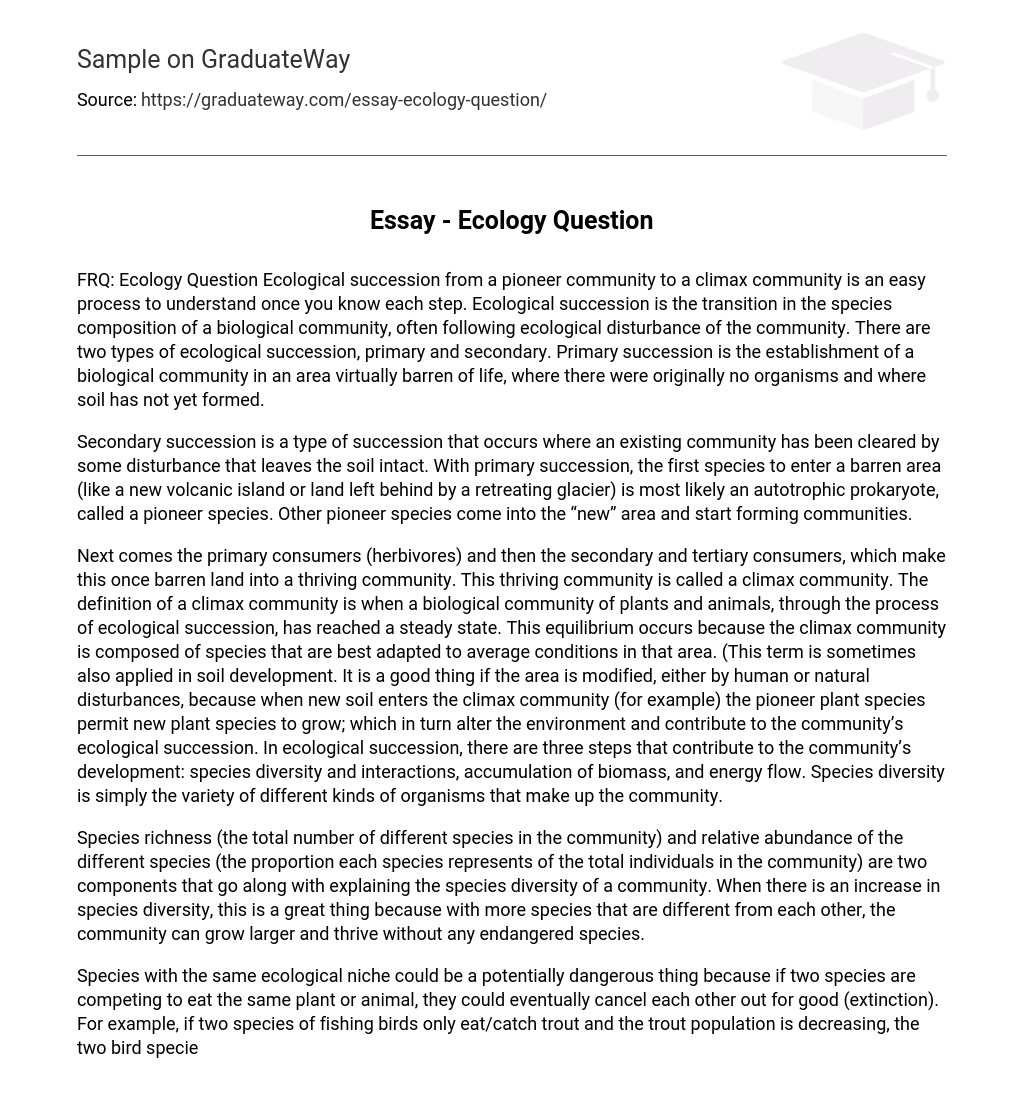FRQ: Ecology Question Ecological succession from a pioneer community to a climax community is an easy process to understand once you know each step. Ecological succession is the transition in the species composition of a biological community, often following ecological disturbance of the community. There are two types of ecological succession, primary and secondary. Primary succession is the establishment of a biological community in an area virtually barren of life, where there were originally no organisms and where soil has not yet formed.
Secondary succession is a type of succession that occurs where an existing community has been cleared by some disturbance that leaves the soil intact. With primary succession, the first species to enter a barren area (like a new volcanic island or land left behind by a retreating glacier) is most likely an autotrophic prokaryote, called a pioneer species. Other pioneer species come into the “new” area and start forming communities.
Next comes the primary consumers (herbivores) and then the secondary and tertiary consumers, which make this once barren land into a thriving community. This thriving community is called a climax community. The definition of a climax community is when a biological community of plants and animals, through the process of ecological succession, has reached a steady state. This equilibrium occurs because the climax community is composed of species that are best adapted to average conditions in that area. (This term is sometimes also applied in soil development. It is a good thing if the area is modified, either by human or natural disturbances, because when new soil enters the climax community (for example) the pioneer plant species permit new plant species to grow; which in turn alter the environment and contribute to the community’s ecological succession. In ecological succession, there are three steps that contribute to the community’s development: species diversity and interactions, accumulation of biomass, and energy flow. Species diversity is simply the variety of different kinds of organisms that make up the community.
Species richness (the total number of different species in the community) and relative abundance of the different species (the proportion each species represents of the total individuals in the community) are two components that go along with explaining the species diversity of a community. When there is an increase in species diversity, this is a great thing because with more species that are different from each other, the community can grow larger and thrive without any endangered species.
Species with the same ecological niche could be a potentially dangerous thing because if two species are competing to eat the same plant or animal, they could eventually cancel each other out for good (extinction). For example, if two species of fishing birds only eat/catch trout and the trout population is decreasing, the two bird species will compete against each other and eventually one species will die off because there will not be enough food for both species.
If there is a change in population density in the primary producers (for example), the whole community is affected because if there are fewer producers to eat, then there are less primary consumers to eat, and so on. Ecologists can figure out a community’s diversity by making a food chain, which is the transfer of food energy up the trophic levels from its source in plants and other photosynthetic organisms through herbivores to carnivores, and eventually to the decomposers. A food web, which is used for measuring a community’s trophic structure, is a group of food chains that are linked together.
R/K strategy (or selection) relates to the selection of combinations of traits that trade off the quality and quantity of offspring to promote success in particular environments. If there is a change in a symbiotic relationship, it could either lead to extinction of a species or the evolution of a new one. Since the symbiotic relationship between the species has been there for awhile and there is suddenly a change, it could be good or bad. Biomass is the dry weight of organic matter comprising a group of organsims in a particular environment, or simply the total mass of all individuals in a population.
The levels of organization of a community is simple. It starts with the primary producer, then the primary consumer, secondary consumer, tertiary consumer, and lastly the decomposer. Some examples of producers are algae, sea weed, and any other type of potosynthetic organism. A pyramid of production is a pyramid that shows the loss of energy with each transfer in a food chain. At the bottom of the pyramid are the large amount of autotrophs with the most energy. The next (but smaller) level is he group of primary consumers (insects and other herbivores) who only get ten percent of the autotroph’s energy. Next are the small group of secondary consumers, who only get ten percent of the primary consumer’s energy. The top level consists of the smallest group, the tertiary consumers who only receive ten percent of the secondary consumer’s energy. Energy is a very important part of the ecosystem because all autotrophs or primary producers make it, and the rest of the community depends on them to survive.
The sun may be the most crucial part of the ecosystem because the autotrophs use the sun’s light and convert it into energy. Without the sun, one could say the earth would be barren and dry with no living creatures. Autotrophs use photosynthesis to make energy. Photosynthesis is the conversion of light energy to chemical energy that is stored in glucose or other organic compounds. In conclusion, ecological succession has three main components that help develop a pioneer community to a climax community: energy flow, species diversity, and biomass.





